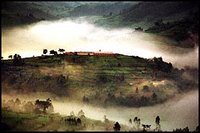
Rwanda, officially the Republic of Rwanda, is a small landlocked country in the Great Lakes region of east-central Africa, with a population of approximately 9 million. It is bordered by Uganda, Burundi, the Democratic Republic of the Congo and Tanzania . Its fertile and hilly terrain, which gives it the title "Land of a Thousand Hills", supports the densest populations in continental Africa. It is best known to the outside world for the 1994 Rwandan genocide1994 Rwanda genocide that resulted in the deaths of up to one million people.
 High dependence on subsistence agriculture, high (and increasing) population density, decreasing soil fertility and uncertain climate make Rwanda a country where chronic malnutrion is widespread and poverty endemic.
High dependence on subsistence agriculture, high (and increasing) population density, decreasing soil fertility and uncertain climate make Rwanda a country where chronic malnutrion is widespread and poverty endemic.
 The 1994 genocide killed 800,000 people, deeply traumatised Rwanda’s population (343,1 hab./km2), broke its social structures and brought its economy to a halt. Regional insecurity in the Great Lakes added to refugee flows, security concerns in border areas and lost economic opportunities. More than 50,000 Rwandans are still refugees in other countries of Africa and are only slowly returning. Broken families, a large number of women-headed households and orphans created an important group of vulnerable people. Malnutrition and HIV/AIDS further aggravate the situation.
The 1994 genocide killed 800,000 people, deeply traumatised Rwanda’s population (343,1 hab./km2), broke its social structures and brought its economy to a halt. Regional insecurity in the Great Lakes added to refugee flows, security concerns in border areas and lost economic opportunities. More than 50,000 Rwandans are still refugees in other countries of Africa and are only slowly returning. Broken families, a large number of women-headed households and orphans created an important group of vulnerable people. Malnutrition and HIV/AIDS further aggravate the situation.

Rwanda has limited natural resources and one of the highest population densities in Africa -- estimated at 343 inhabitants per square kilometre. Ninety percent of the population depends on agriculture. Small family plots, decreasing soil fertility, low use of agricultural inputs and erratic rainfall result in chronic and often acute food insecurity. About 10–12 percent of the population suffers from food insecurity every year. Rwanda is ranked 159 out of 177 countries in the UNDP Human Development Report for 2005. More than 60 percent of the population lives below the poverty line.

Preliminary findings of the 2005 demographic and health survey indicate that chronic and acute malnutrition prevalence in children under five is 45 percent and 19 percent respectively. Infant and under-five child mortality rates are still among the highest in the world at 110/1,000 and 195/1,000, respectively. Maternal mortality rate is among the highest in sub-Saharan Africa at 1,000/100,000 live births.
Rwanda is slowly recovering and making remarkable progress having gained donor confidence. The Government is committed to providing universal primary education to all Rwandans by 2010. However, chronic food insecurity, frequent droughts and chronic poverty prevent many children, especially girls, from enrolling in schools, forcing them to be frequently absent, reducing their learning abilities, academic performance and completion of their primary education. The government and donor community are united to combat HIV/AIDS with encouraging results. For ARV treatment to succeed, good nutrition is identified as an important challenge.

All this information is collected from web-pages about Rwanda. Some of the dates could be aproximated and not exact.
If you are interested the movie Hotel Rwanda is a very interested proof of the 1994 genocide
Capital: Kigali
Land area: 26.340 km2
Population: 9.038.000
Languages: kinyarwanda, francés, inglés, swahili, ...
Density: 343,1 hab./km2
Children mortality rate:115,5 por 1.000
Expectancy of life:43,6 años
Illiteracy rate: 29,5 % in men and 41,2 % in women
Internet: 3,06 per 1.000 hab.

 High dependence on subsistence agriculture, high (and increasing) population density, decreasing soil fertility and uncertain climate make
High dependence on subsistence agriculture, high (and increasing) population density, decreasing soil fertility and uncertain climate make  The 1994 genocide killed 800,000 people, deeply traumatised
The 1994 genocide killed 800,000 people, deeply traumatised 






No hay comentarios:
Publicar un comentario